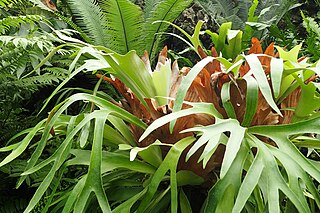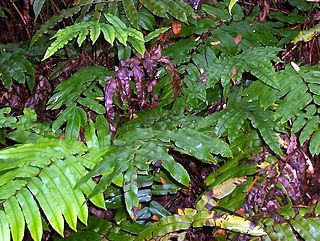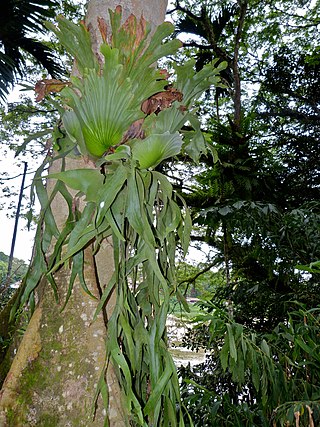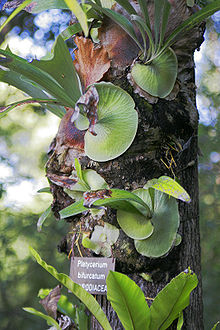
The ferns are a group of vascular plants that reproduce via spores and have neither seeds nor flowers. They differ from mosses by being vascular, i.e., having specialized tissues that conduct water and nutrients and in having life cycles in which the branched sporophyte is the dominant phase.

Pleopeltis polypodioides, also known as the resurrection fern, is a species of creeping, coarse-textured fern native to the Americas and Africa.

Dicksonia antarctica, the soft tree fern or man fern, is a species of evergreen tree fern native to eastern Australia, ranging from south-east Queensland, coastal New South Wales and Victoria to Tasmania.

Davallia is a genus of about 40 species of fern. In the Pteridophyte Phylogeny Group classification of 2016, it is the only genus in the family Davalliaceae, which is placed in the suborder Polypodiineae, order Polypodiales. Alternatively, the family may be placed in a very broadly defined family Polypodiaceae sensu lato as the subfamily Davallioideae.

Phlebodium aureum is an epiphytic fern native to tropical and subtropical regions of the Americas.

Aglaomorpha fortunei, commonly known as gu-sui-bu, is a species of basket fern of the family Polypodiaceae. The plant is native to Eastern Asia, including eastern China.

Ceratopteris is the only genus among homosporous ferns that is exclusively aquatic. It is pan-tropical and classified in the Parkerioideae subfamily of the family Pteridaceae.

Phlebodium is a small genus of ferns in the family Polypodiaceae, subfamily Polypodioideae, according to the Pteridophyte Phylogeny Group classification of 2016 (PPG I). It is native to tropical and subtropical regions of the Americas. Its species were formerly included in Polypodium.

Platycerium bifurcatum, commonly known as the elkhorn fern or staghorn fern, is a species of plant in the fern family Polypodiaceae native to Java, New Guinea, New South Wales, Queensland and Lord Howe Island.

Platycerium superbum, commonly known as the staghorn fern, is a Platycerium species of fern. It is native to Australia.

Parablechnum wattsii, synonym Blechnum wattsii, is a common terrestrial fern growing in rainforest and open forest. It is often seen near creeks in much of south eastern Australia, including Victoria, Tasmania, South Australia, New South Wales and Queensland. The specific epithet wattsii honours William Walter Watts (1856-1920). Watts was considered an authority on mosses and ferns and has more than 30 species named for him. Common names by which the species may be called are hard water fern - from its stiff leathery fronds, leech fern - as forest workers often encounter leaches while working in clusters of these ferns, hard hill fern - from the fern's habit and habitat, and red cabbage fern - from the bronze-pink colour of the young fronds resembling cooked red cabbage.

Lomaria nuda, commonly known as the fishbone waterfern, is a fern that grows up to a metre tall, and is abundant in rainforest and eucalyptus forests in eastern Australia. The species is placed in the genus Lomaria in the Pteridophyte Phylogeny Group classification of 2016, but is often retained in genus Blechnum as Blechnum nudum.
Cheiroglossa palmata, synonyms Ophioderma palmatum and Ophioglossum palmatum, variously known as hand fern, dwarf staghorn, or hand tongue, is an epiphytic or terrestrial fern. As an epiphyte it grows in old leaf bases of the cabbage palmetto.

Aglaomorpha is a genus of ferns in the subfamily Drynarioideae of the family Polypodiaceae. The Pteridophyte Phylogeny Group classification of 2016 uses this genus name, while other sources use Drynaria to include Aglaomorpha. Species are commonly known as basket ferns. As circumscribed in PPG I, the genus contains around 50 species.

Asplenium tutwilerae is a rare epipetric fern found only in Hale County, Alabama, United States. A. tutwilerae is a fertile allotetraploid, formed by the chromosomal doubling of a specimen of the sterile diploid A. × ebenoides, a hybrid of A. platyneuron and A. rhizophyllum. Except for its spores, which are fertile rather than malformed, A. tutwilerae is essentially identical to A. × ebenoides and was described as part of that species until 2007. It is named in honor of Julia Tutwiler, who discovered the only known wild population at Havana Glen in 1873.

Platycerium coronarium is an epiphytic species of staghorn fern in the genus Platycerium. It is found in maritime Southeast Asia and Indochina. and throughout the East Indies. It produces two kinds of leaves: Foliage leaves which are broad and upright in habit, and spore bearing leaves which are narrow, pendulous, dichotomously lobed and up to fifteen feet in length.

Dipteris is a genus of about seven species of ferns, native to tropical regions across the world, particularly Asia, with a species in northeastern Queensland in Australia. It is one of two genera in the family Dipteridaceae.

Platycerium grande, the giant staghorn fern, capa de leon, and dapong repolyo, is a species of epiphytic fern in the family Polypodiaceae. It is one of the two staghorn ferns native to the Philippines, along with P. coronarium, and is endemic to the island of Mindanao, in the provinces of Zamboanga, Lanao and Davao. P. grande is often collected from the forests and sold as a highly prized ornamental plant. Due to overcollection and the difficulty of the spores to germinate under natural conditions, in vitro technique is necessary to ensure mass production of this plant species. The local government categorized it as critically endangered species.

Hymenophyllum rarum, the narrow filmy-fern, is a species of fern from the family Hymenophyllaceae. This thin-leaved fern is commonly found in New Zealand and Tasmania, growing in patches on rocks and is epiphytic on trees and tree ferns, growing in moist gullies or rainforests. A rather drought tolerant species often found at exposed sites ranging from coastal to montane areas. Forming extensive, interwoven and creeping patches with its thin long (creeping) rhizomes sparsely covered in red-brown hairs, easily recognised by its membranous grey-green fronds, the smooth margins of the pinnae, ultimate segments and indusia; and by the sunken sori in the uppermost segments of the uppermost pinnae. The species can be found throughout Tasmanian rainforests as well as occurring in New South Wales, Victoria and New Zealand on the North and South Islands as well as, Stewart, Chatham and Auckland Islands.
Dendroconche annabellae is a species of fern in the family Polypodiaceae, subfamily Microsoroideae. It is endemic to Papua New Guinea.






































